Chemical substance
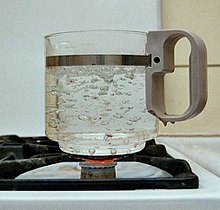
A chemical substance is a unique form of matter with constant chemical composition and characteristic properties.[1][2] Chemical substances may take the form of a single element or chemical compounds. If two or more chemical substances can be combined without reacting, they may form a chemical mixture.[3] If a mixture is separated to isolate one chemical substance to a desired degree, the resulting substance is said to be chemically pure.[4]
Chemical substances can exist in several different physical
Pure
Definitions
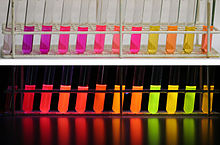
In addition to the generic definition offered above, there are several niche fields where the term "chemical substance" may take alternate usages that are widely accepted, some of which are outlined in the sections below.
Inorganic chemistry
Chemical Abstracts Service (CAS) lists several alloys of uncertain composition within their chemical substance index.[5] While an alloy could be more closely defined as a mixture, referencing them in the chemical substances index allows CAS to offer specific guidance on standard naming of alloy compositions. Non-stoichiometric compounds are another special case from inorganic chemistry, which violate the requirement for constant composition. For these substances, it may be difficult to draw the line between a mixture and a compound, as in the case of palladium hydride. Broader definitions of chemicals or chemical substances can be found, for example: "the term 'chemical substance' means any organic or inorganic substance of a particular molecular identity, including – (i) any combination of such substances occurring in whole or in part as a result of a chemical reaction or occurring in nature".[6]
Geology
In the field of geology, inorganic solid substances of uniform composition are known as minerals.[7] When two or more minerals are combined to form mixtures (or aggregates), they are defined as rocks.[8] Many minerals, however, mutually dissolve into solid solutions, such that a single rock is a uniform substance despite being a mixture in stoichiometric terms. Feldspars are a common example: anorthoclase is an alkali aluminum silicate, where the alkali metal is interchangeably either sodium or potassium.
Law
In law, "chemical substances" may include both pure substances and mixtures with a defined composition or manufacturing process. For example, the
Polymer chemistry
History
The
Chemical elements
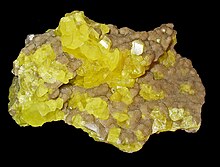
An element is a chemical substance made up of a particular kind of atom and hence cannot be broken down or transformed by a chemical reaction into a different element, though it can be transmuted into another element through a nuclear reaction. This is because all of the atoms in a sample of an element have the same number of protons, though they may be different isotopes, with differing numbers of neutrons.
As of 2019, there are 118 known elements, about 80 of which are stable – that is, they do not change by
Chemical compounds

A chemical compound is a chemical substance that is composed of a particular set of atoms or ions. Two or more elements combined into one substance through a chemical reaction form a chemical compound. All compounds are substances, but not all substances are compounds.
A chemical compound can be either atoms
Compounds in which components share electrons are known as
In organic chemistry, there can be more than one chemical compound with the same composition and molecular weight. Generally, these are called
However, tautomers are an exception: the isomerization occurs spontaneously in ordinary conditions, such that a pure substance cannot be isolated into its tautomers, even if these can be identified spectroscopically or even isolated in special conditions. A common example is glucose, which has open-chain and ring forms. One cannot manufacture pure open-chain glucose because glucose spontaneously cyclizes to the hemiacetal form.
Substances versus mixtures
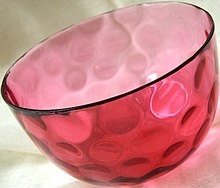
All matter consists of various elements and chemical compounds, but these are often intimately mixed together. Mixtures contain more than one chemical substance, and they do not have a fixed composition. Butter, soil and wood are common examples of mixtures. Sometimes, mixtures can be separated into their component substances by mechanical processes, such as chromatography, distillation, or evaporation.[13]
Grey iron metal and yellow sulfur are both chemical elements, and they can be mixed together in any ratio to form a yellow-grey mixture. No chemical process occurs, and the material can be identified as a mixture by the fact that the sulfur and the iron can be separated by a mechanical process, such as using a magnet to attract the iron away from the sulfur.
In contrast, if iron and sulfur are heated together in a certain ratio (1 atom of iron for each atom of sulfur, or by weight, 56 grams (1 mol) of iron to 32 grams (1 mol) of sulfur), a chemical reaction takes place and a new substance is formed, the compound iron(II) sulfide, with chemical formula FeS. The resulting compound has all the properties of a chemical substance and is not a mixture. Iron(II) sulfide has its own distinct properties such as melting point and solubility, and the two elements cannot be separated using normal mechanical processes; a magnet will be unable to recover the iron, since there is no metallic iron present in the compound.
Chemicals versus chemical substances
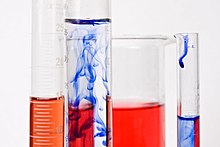
While the term chemical substance is a precise technical term that is synonymous with chemical for chemists, the word chemical is used in general usage to refer to both (pure) chemical substances and mixtures (often called compounds),[14] and especially when produced or purified in a laboratory or an industrial process.[15][16][17] In other words, the chemical substances of which fruits and vegetables, for example, are naturally composed even when growing wild are not called "chemicals" in general usage. In countries that require a list of ingredients in products, the "chemicals" listed are industrially produced "chemical substances". The word "chemical" is also often used to refer to addictive, narcotic, or mind-altering drugs.[15][16]
Within the chemical industry, manufactured "chemicals" are chemical substances, which can be classified by production volume into bulk chemicals, fine chemicals and chemicals found in research only:
- Bulk chemicals are produced in very large quantities, usually with highly optimized continuous processes and to a relatively low price.
- Fine chemicals are produced at a high cost in small quantities for special low-volume applications such as biocides, pharmaceuticals and speciality chemicals for technical applications.
- Research chemicals are produced individually for research, such as when searching for synthetic routes or screening substances for pharmaceutical activity. In effect, their price per gram is very high, although they are not sold.
The cause of the difference in production volume is the complexity of the molecular structure of the chemical. Bulk chemicals are usually much less complex. While fine chemicals may be more complex, many of them are simple enough to be sold as "building blocks" in the synthesis of more complex molecules targeted for single use, as named above. The production of a chemical includes not only its synthesis but also its purification to eliminate by-products and impurities involved in the synthesis. The last step in production should be the analysis of batch lots of chemicals in order to identify and quantify the percentages of impurities for the buyer of the chemicals. The required purity and analysis depends on the application, but higher tolerance of impurities is usually expected in the production of bulk chemicals. Thus, the user of the chemical in the US might choose between the bulk or "technical grade" with higher amounts of impurities or a much purer "pharmaceutical grade" (labeled "USP", United States Pharmacopeia). "Chemicals" in the commercial and legal sense may also include mixtures of highly variable composition, as they are products made to a technical specification instead of particular chemical substances. For example, gasoline is not a single chemical compound or even a particular mixture: different gasolines can have very different chemical compositions, as "gasoline" is primarily defined through source, properties and octane rating.
Naming and indexing
Every chemical substance has one or more
Many compounds are also known by their more common, simpler names, many of which predate the systematic name. For example, the long-known
| Common name | Systematic name |
Chemical formula | Chemical structure | CAS registry number |
InChI |
|---|---|---|---|---|---|
| Alcohol, or ethyl alcohol |
Ethanol | C2H5OH | [64-17-5] | 1/C2H6O/c1-2-3/h3H,2H2,1H3 |
Isolation, purification, characterization, and identification
Often a pure substance needs to be isolated from a mixture, for example from a natural source (where a sample often contains numerous chemical substances) or after a chemical reaction (which often gives mixtures of chemical substances).
Measurement
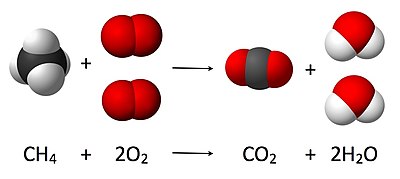
Stoichiometry is founded on the
This is illustrated in the image here, where the balanced equation is:
- CH4 + 2 O2 → CO2 + 2 H2O
Here, one molecule of methane reacts with two molecules of oxygen gas to yield one molecule of carbon dioxide and two molecules of water. This particular chemical equation is an example of complete combustion. Stoichiometry measures these quantitative relationships, and is used to determine the amount of products and reactants that are produced or needed in a given reaction. Describing the quantitative relationships among substances as they participate in chemical reactions is known as reaction stoichiometry. In the example above, reaction stoichiometry measures the relationship between the quantities of methane and oxygen that react to form carbon dioxide and water.
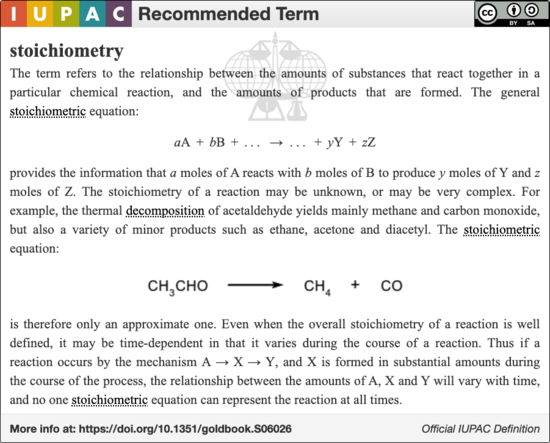
Because of the well known relationship of moles to atomic weights, the ratios that are arrived at by stoichiometry can be used to determine quantities by weight in a reaction described by a balanced equation. This is called composition stoichiometry.
Gas stoichiometry deals with reactions involving gases, where the gases are at a known temperature, pressure, and volume and can be assumed to be ideal gases. For gases, the volume ratio is ideally the same by the ideal gas law, but the mass ratio of a single reaction has to be calculated from the molecular masses of the reactants and products. In practice, because of the existence of isotopes, molar masses are used instead in calculating the mass ratio.See also
- Hazard symbol
- Homogeneous and heterogeneous mixtures
- Prices of chemical elements
- Dedicated bio-based chemical
- Fire diamond
- Research chemical
References
- ISBN 9780191648342. Archivedfrom the original on 2018-01-13.
- ^ "2.1: Pure Substances and Mixtures". Chemistry LibreTexts. 2017-03-15. Retrieved 2024-01-07.
- ISBN 9780262299947. Archivedfrom the original on 2018-01-13.
- ^ Appendix IV: Chemical Substance Index Names Archived 2007-12-03 at the Wayback Machine
- ^ "What is the TSCA Chemical Substance Inventory?". US Environmental Protection Agency. Archived from the original on 2009-06-05. Retrieved 2009-10-19.
- ^ "Mineral | Types & Uses | Britannica". www.britannica.com. 2023-12-22. Retrieved 2024-01-20.
- ^ "Rock | Definition, Characteristics, Formation, Cycle, Classification, Types, & Facts | Britannica". www.britannica.com. Retrieved 2024-01-20.
- ^ Hill, J. W.; Petrucci, R. H.; McCreary, T. W.; Perry, S. S. General Chemistry, 4th ed., p37, Pearson Prentice Hall, Upper Saddle River, New Jersey, 2005.
- ^ Law of Definite Proportions Archived November 18, 2007, at the Wayback Machine
- ^ Hill, J. W.; Petrucci, R. H.; McCreary, T. W.; Perry, S. S. General Chemistry, 4th ed., pp 45–46, Pearson Prentice Hall, Upper Saddle River, New Jersey, 2005.
- ^ The boundary between metalloids and non-metals is imprecise, as explained in the previous reference.
- ^ "1.16: Methods for Separating Mixtures". Chemistry LibreTexts. 2019-09-19. Retrieved 2024-01-07.
- ^ compound Archived 2017-11-07 at the Wayback Machine in Oxford Online Dictionaries
- ^ a b chemical Archived 2017-11-07 at the Wayback Machine in Oxford Online Dictionaries
- ^ a b Random House Unabridged Dictionary Archived 2017-11-07 at the Wayback Machine, 1997
- ^ "What is a chemical". Nicnas.gov.au. 2005-06-01. Archived from the original on 2013-06-16. Retrieved 2013-06-06.
- ^ Joachim Schummer. "Coping with the Growth of Chemical Knowledge: Challenges for Chemistry Documentation, Education, and Working Chemists". Rz.uni-karlsruhe.de. Archived from the original on 2013-09-17. Retrieved 2013-06-06.
- ^ "Chemical Abstracts substance count". Cas.org. Retrieved Feb 15, 2021.
External links
 Media related to Chemical substances at Wikimedia Commons
Media related to Chemical substances at Wikimedia Commons

